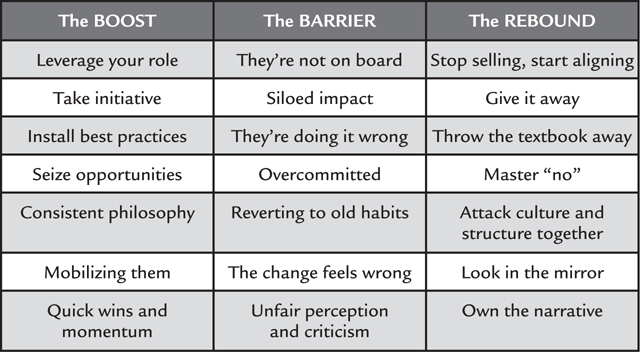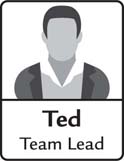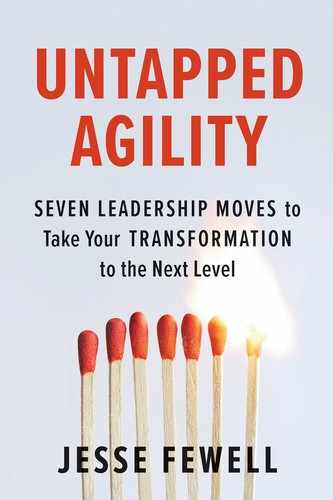CHAPTER 9
Transforming Your Transformation
In the previous chapters, we have discussed a recurring pattern around leading change. Whether it is buy-in, impact, practices, workload, philosophy, your actual leadership skills, or even just the perception of those skills, we have seen this pattern:
• The Boost. Yes, leaders start with the right things.
• The Barrier. And yet, we experience common, frustrating barriers.
• The Rebound. But a leadership move in the seemingly opposite direction will yield further gains.
To paint the picture another way, the next figure shows all the untapped agility patterns.
If it feels like a lot, it is. Organizations are complex organisms. Even if it’s not a surprise that there are so many things to keep in mind, it’s still a bit overwhelming.
Therefore, in this final chapter, we will cover the topics you need to gain confidence and clarity in moving forward. Specifically, we will look at:
• Untapped principles. These are the recurring themes that have emerged over the seven leadership patterns.
• Curveballs and landmines. Here we share several additional frustrations and barriers that can further complicate the ones already discussed.
• Getting going. Finally, we list some concrete suggestions for taking action.
The Seven Untapped Agility Patterns

Let’s see how we go about transforming our transformations.
Untapped Principles
If you felt that there were some similarities among the seven transformation patterns we’ve discussed, I agree with you. Beyond the core untapped agility pattern itself, a few pervasive themes have emerged.
Embrace the Roller Coaster
Change is a messy business. One overarching theme we’ve seen across these seven patterns is the high of getting started, followed by the low of frustration, followed by the high of new opportunity. Transformation does not go in a straight line, it goes up and down.
Unfortunately, most of us have been trained as leaders to develop the single right plan at the very beginning. Failure, therefore, is either the result of inadequate planning, incompetent execution, or both. Well, that might be true for certain business functions like onboarding a new hire or securing a line of credit, but it’s simply the wrong analytical mindset for organizational change.
Recall in chapter 7 that Brian made the right move by installing practices he learned during a training workshop. However, when successes started compounding, it quickly felt out of control. Eventually, he grew new personal leadership capacities that allowed him to get on top of the chaos. Elsewhere, we learned with the J-curve that many human systems go up and then down and then up again. The principle here is to embrace the mess, to get comfortable being uncomfortable. Leadership itself is hard enough, but when you start venturing into new realities, the path of leadership starts to look more like a roller coaster.
It’s Never Done Right the First Time—Just Start
Change is easy in the beginning. We haven’t tried anything yet, which means we haven’t screwed anything up yet. Then, as the roller coaster starts, we start feeling a few bruises and shocks. Some of us will quickly brush off that initial surprise and continue plowing forward a little bit longer. But in the end, all of us will run into frustrations when it comes to leading the kind of transformative changes we want to last. In chapter 4, we heard the story of navy commander Dave Marquet, who found the one unique way his specific leadership team wanted to be empowered. However, another fascinating part of his story is that it was his third time attempting to build such a transformative culture. He tried making similar cultural changes in his previous assignments, with very frustrating results. In chapter 5, we saw Luis encouraging all-hands retrospective, which revealed negative feedback on some of the initial changes made.
Bottom line? Your first attempts will never be perfect, but they will be close enough to get started. Let go of your need to figure it out before getting started.
It’s Never Too Late to Pivot
Just because you have a plan doesn’t mean you have to follow it. General Dwight D. Eisenhower famously said, “In preparing for battle, I have always found that plans are useless but planning is indispensable.” Perhaps you are already well into a comprehensive transformation roadmap; you’ve successfully formalized a center of excellence and rolled out a very robust practices playbook. After reading this book, you are probably rethinking that current state and wondering if you just made a whole bucket load of mistakes.
Don’t forget, those are not mistakes. They are the first steps. But now is very much the right time to begin thinking about your next adjustment, your next pivot on the transformation journey. If you’re worried about how it might look for you to alter your strategy, don’t. In chapter 8, we offered guidance on how to craft a story that includes the past, the present, and the future. The best way to emulate the adaptability that you are trying to encourage in your organization is to adapt the change itself as you gather new information, gain allies, and score wins.
“Done” Is in the Eye of the Beholder
I recently volunteered at a conference booth offering free advice to change practitioners. One agile coach, John (not his real name), came to the booth seeking tips for a key frustration: he was bored. He had built a really strong transformation team, which had achieved some exciting new capabilities over the last couple of years. However, now that the more difficult problems had been solved, his team was able to take more and more responsibility, leaving him underutilized. He was fully convinced he was doing something wrong. I asked him, “What if all this means that you’ve done what you came to do?” His eyes lit up with the possibility, and we started brainstorming new ideas and new places for his career to go.
Then there’s General Electric. We’ve mentioned them a couple of times in this book. The question of whether their $4 billion transformation was a success depends on whom you ask. On the one hand, the new digital capabilities across the corporate family of companies have yielded a modern wave of innovation that would not have otherwise happened. On the other hand, that innovation was not enough to overcome some of the more fundamental systemic issues that have since caused the stock price to suffer and some of those companies to be sold off. And yet, GE’s transformation efforts continue. At the time of the writing of this book, I facilitated a leadership workshop at GE Aviation, where senior leaders were talking about how to continue evolving into a productized organization. For many, there’s a lot more work to be done, despite all of the work done so far.
So here’s the principle to keep in mind: if you think you’re done, someone in your leadership team might disagree. Conversely, if you think you’ve only just begun, you might be shocked to hear your peers say further investment is no longer justified.
Curveballs and Landmines
The seven frustrations and barriers we’ve covered throughout this book are not the only ones you will come up against. There are a few others that can emerge on their own or further aggravate any of those already discussed. I could write another entire book on these, but I include some quick thoughts here, so that you don’t feel completely alone or completely ambushed.
The New Boss Has Maria Feeling in Limbo

“New leadership has been installed, threatening to alter or even undo all our transformation efforts. What do I do?”
First, get on the new leader’s radar. Schedule time to walk through new organizational results achieved with your agile/digital/DevOps/lean transformation. Let me emphasize here that you lead with the results, and talk about the technical details secondarily. As you talk, categorize the new leader into one of these three categories:
• Mostly aligned. The boss appreciates the new outcomes (speed, quality). She may have some opinions about adjusting the organizational structure, culture, or practices. But mostly you’re on the same page.
• Mixed minds. In this case, the boss likes some parts of your story but is not on board with other parts.
• Mostly against. Here, the boss fundamentally disagrees. She may say, “I’ve been placed in this role exactly because the transformation isn’t moving fast enough.” Or she may say, “That’s all well and good, but any solid organization needs to respect the chain of command, and that’s what we’re going to emphasize.” You leave this conversation knowing you no longer have the support you used to have.
My experience tells me each of these is equally likely. Regardless of which category your boss fits into, you will need to choose your battles. Knowing the leader’s position will help you choose the right battles going forward. Go back and study the ideas in chapter 2 to help with that.
For the leader who is mostly against your changes, you have two choices: wait it out or leave. Some organizations have a lot of churn at the management levels with frequent reorganization and reassignments. In these cases, it could be a wise move to hold firm, lay low, and then try again with the next leader. If you sense this new person is going to be around for a while, it might be time to find a new work environment that better aligns with your values and dreams.
The Mass Exodus Has Emmit Worried

“I’ve lost my best talent over the last few months. This transformation was supposed to improve engagement and retention, and it’s had the opposite effect. What’s going on?”
Professionals have a fairly high pain tolerance for frustrating work environments. One survey shows that nearly half of all US employees are essentially ready to leave their company right now.1 Common motivators range from lack of advancement opportunities to work flexibility and the relationship with a direct supervisor.
So more employees than you think are already on the brink of leaving. Then add to that mix the reality of unexplained changes in how business is done. When we talk about building a modern culture of self-organizing teams, supervisors are left wondering how they can contribute value. When we talk about expecting technology professionals to perform both development and testing responsibilities, they interpret that as an excuse to reduce head count.
When I attended my first workshop on agile methods in 2006, Scrum cofounder Ken Schwaber told us to expect a third of our staff to opt out of the change by leaving their jobs and half of management to leave as well. Those were his own anecdotal estimates, but the point holds: tension plus change is a recipe for attrition.
So what do we do?
1. Prepare for the blowback. Have the easiest answers ready. “No, this is not a reduction in workforce.” “No, we are not changing all our practices at once.” “No, we are not doing this everywhere right away; it will start with pilots here and here.”
2. Overcommunicate. In chapter 2, we talked about the criticality of messaging and repetition.
3. Accept that some will not journey with you. No matter how hard you try, there will always be a meaningful minority of people who are just not able to go through the change. Let them leave. Their absence will create the space for new people who better align to the organization’s future.
The Last Straw Has Ted Discouraged

“I’ve been at this for a while, but it’s just not going well. Between the disappointment and the criticism, I’m ready to throw in the towel. How do you know when enough is enough?”
1. Remember that pain is part of growth. Let’s go back to that J-curve, where we learned that things get worse before they get better. In case it’s not obvious, this sucks. Recall in chapter 2, Gretchen waited years before things started to settle into a new groove.
2. Find a support system. Connect with others in the office who think like you do. Even if their tips and suggestions don’t land perfectly, the emotional support will keep you from losing your mind. If you are the only one at your office, then go to a local meetup to find your kindred spirits.
3. Consider leading somewhere else. Sometimes you try and try, but people don’t come around. At some point, you collect enough data on where your team is at and whether you can wait long enough for them to change far enough fast enough for you to thrive. If your message simply isn’t landing with others, it might be time to move to another place to bring your transformational energies. If that idea makes you cringe, consider whether finding a new role in a new department or new company is really any more painful than the daily pushback. Sometimes it’s time to move on.
Layoffs Make Maria Wonder If It Was Her Fault

“Our company has been struggling for a while, so we started a digital transformation to reclaim our competitive edge. Unfortunately, after a year of training our people and running pilots, the senior leadership laid off 30 percent of the workforce. Was our transformation a failure?”
No, it wasn’t your fault. Rather, it was too little too late. In chapter 8, we explored my experiences at a bank using modern methods incorrectly. Granted, I was able to reclaim some transformational momentum by reframing the narrative, and that kept the program going for a little while longer. Unfortunately, the product venture was too large and ambitious to pass an incremental funding review. As a result, the program was canceled, several team leads and managers were reassigned to other departments and programs, and my own consulting engagement was dissolved. However, despite the collapse of that program, I consider the frustrating turn of events to be a meaningful success.
• First, organizational agility matters just as much as team agility. The bank saved a ton of money by killing a runaway agile project. It turns out they had already implemented the progressive Lean Startup process of metered funding, which we discussed in chapter 5. All of my coaching efforts could not prevent senior leadership from barreling forward on a failed strategy. Instead, modern methods helped accelerate that failure so that we could all move on with the rest of our lives.
• Second, all those people increased their agile IQ. The employees that got reassigned are moving into their new roles with a deeper knowledge and experience of modern methods. They know how to write specifications from a customer perspective, they have felt firsthand the power of cross-functional teams, and many have had their first exposure to short iterative work cycles. That kind of experience will be the foundation for them to contribute more innovation, creativity, and agility in their professional futures.
For these reasons and a few others, I believe there’s no such thing as a truly failed transformation. There are only transformations whose benefits are not the ones anticipated.
Getting Going
The knowledge gained in this book is an important first step. As the saying goes, “Knowledge is power.” But I’d like to add that knowledge without action is a waste of time and money. The laws of physics favor objects in motion, so it’s time for you to get moving.
Get Free Resources
This book comes with a toolkit of simple tools to get you started, free of charge. On the website UntappedAgility.Com, you will find, among other things:
• Blank copies of the agile leadership canvas to fill out at your next leadership team meeting
• Talking points for each of the three personas to begin directing the change narrative
• Untapped Agility book club materials to spark conversation with your colleagues
• Untapped Agility graphics you can use in presentation decks
Get Outside Help
If there’s one thing that is universal, it’s success as a team sport. You cannot do this alone. In order to import and adopt those organizational capabilities you envy in others, you need to go ask them how they did it. Here are some tips on how to do that.
Pursue Learning
You cannot do something until you understand it. You cannot understand something until you know about it. I am a part of the Agile Leadership Journey collective, a group of global thought leaders offering education and training programs to equip leaders in their efforts to achieve organizational agility. You can learn more at AgileLeadershipJourney.com.
Find a Coach
At VirtuallyAgile.com, we are a coalition of coaches and advisors who have made it our life’s work to help you through this stuff. Reach out to us, and we will match you with a guide who has the expertise that fits your situation.
Build a Coalition
Another success pattern is to build a coalition of leaders in similar contexts pursuing a transformation goal similar to yours. Whether through your own initiative or with the help of your coach, reach out to your peers in your space and offer to exchange tips and ideas. Certainly you want to avoid divulging any competitive or proprietary secrets, but you will find there are plenty of people ready to support each other on this journey.
Untapped Agility
In this book, we have explored seven moves to help transformation leaders overcome the most common frustrating barriers to further organizational maturity. Whether you are most like Ted the Team Leader, Maria the Manager, or Emmit the Executive, these moves can offer you more confidence and credibility driving a better way of working.
Now you have what you need to get going. No more excuses. Go transform your transformation, and find that untapped agility.
